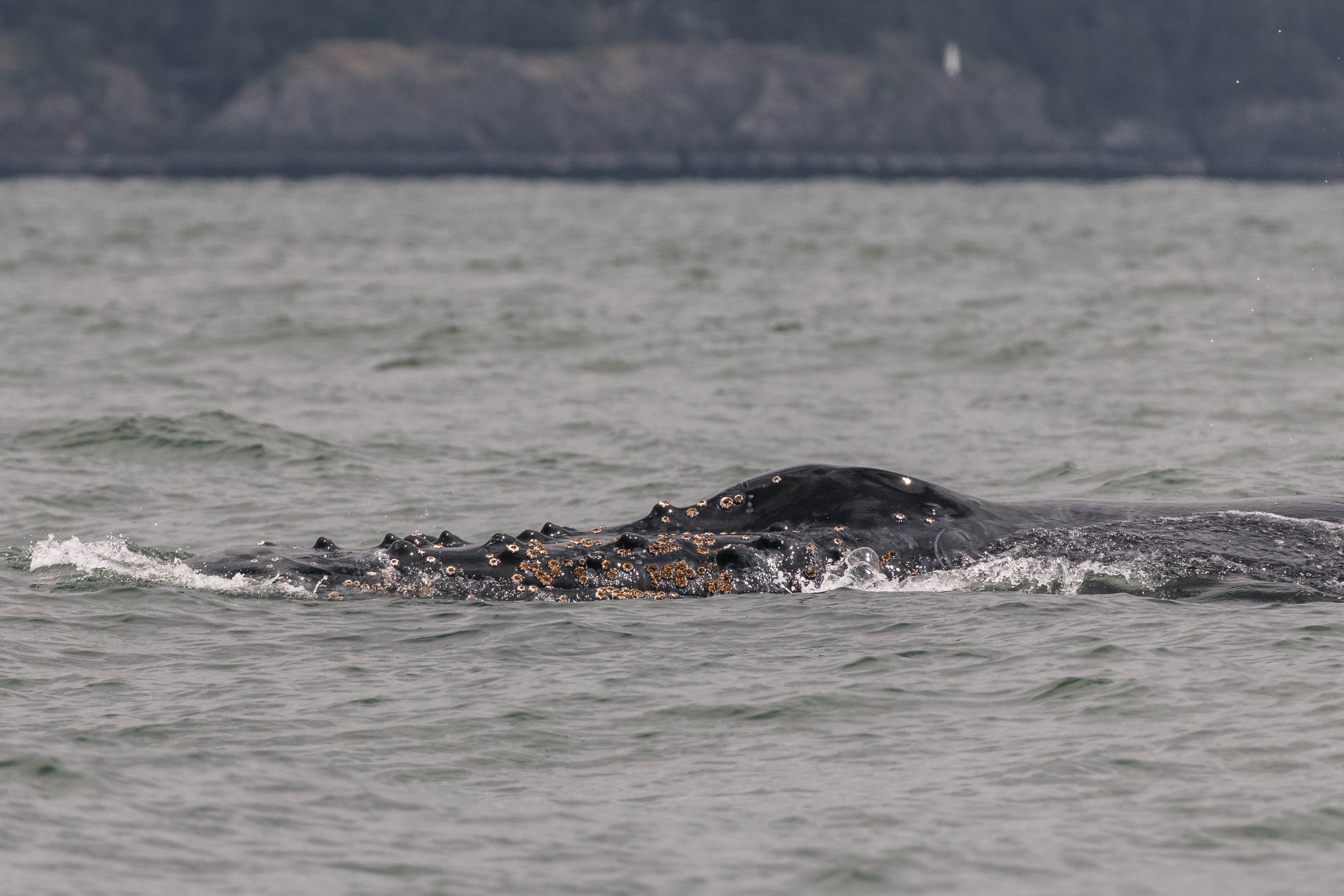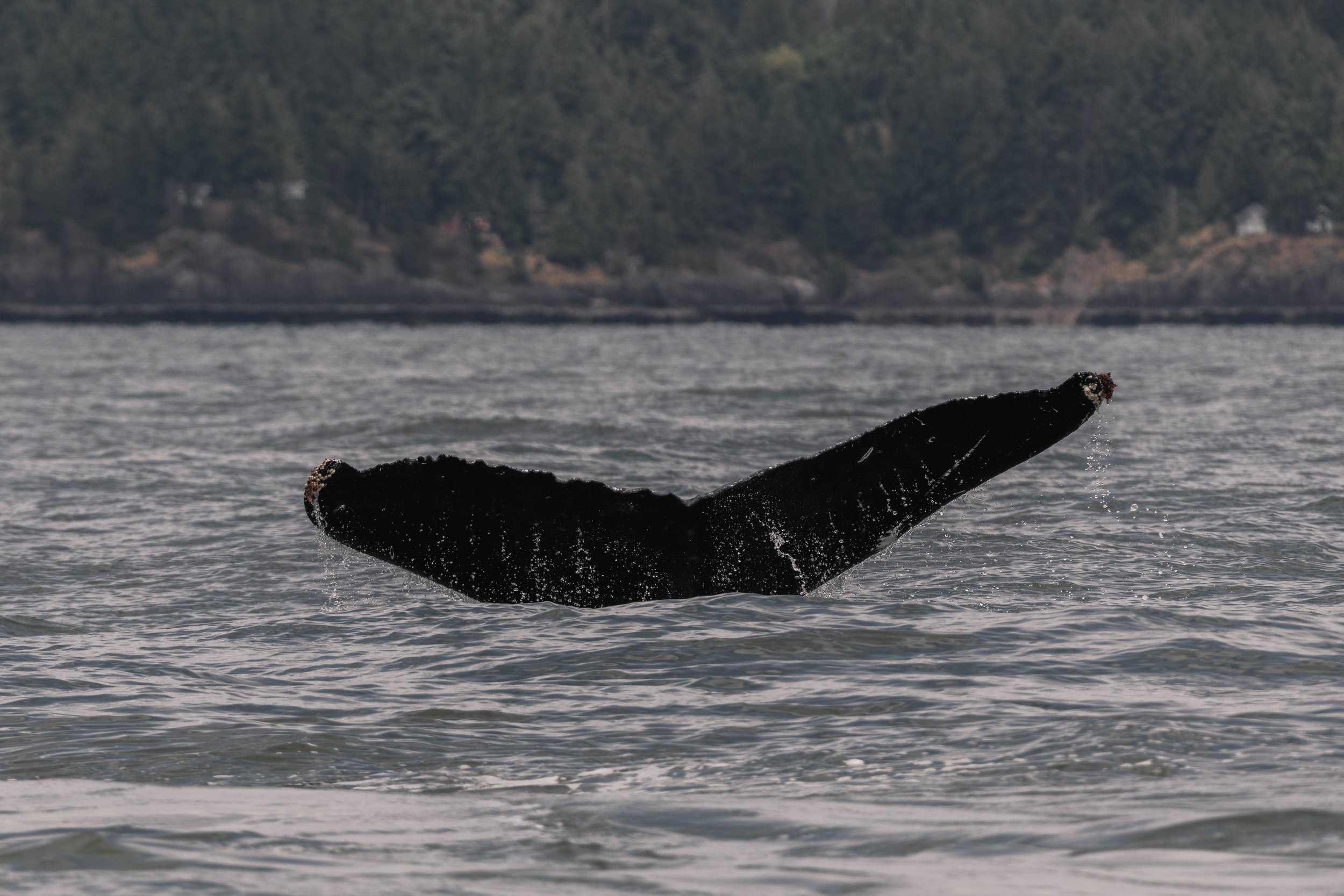June 13, 2025, 10:30 AM - Humpbacks, humpbacks, humpbacks!
Luck was in the air, along with a few clouds, as our full fleet pushed off the dock today. We set our course for the Strait of Georgia, eager to see what wildlife the day might bring. It was one of those mornings where we were searching for quite some time, but we never lost hope. Whales can surface when you least expect it! Sure enough, our persistence paid off as we spotted blows, beautifully backlit against the grey skies. It’s safe to say the humpbacks are beginning to return from their southern breeding grounds!
In total, we encountered seven humpback whales this morning. One individual, still unknown to us, was sighted travelling solo off Valdes Island, perhaps on a mission to join others at a nearby feeding hotspot. Soon after, we came across Spock (BCY1134) and Beak (BCX1606), who appeared to be enjoying each other’s company. Windy (BCY0893) and Spotlight (BCX1480) were also spotted surfacing together in close association. Finally, near Bowen Island, on the opposite side of the Strait from where we saw our first mystery whale, we observed another pair: Slits (BCY0946) accompanied by an unidentified companion. It was a rewarding day on the water, full of promising signs that our returning humpbacks are settling back into their summer feeding grounds.
One thing we did note about these humpbacks is that they had returned with some passengers attached - Barnacles! When you think of barnacles, your mind might drift to wave-battered rocks or the underside of old docks. But some barnacles have taken their lifestyle to a whole new level, literally, by living on the backs of whales. One of the most remarkable examples is the Humpback Whale Barnacle (Coronula diadema), a species so specialized that it can only survive on a living, moving host.
Coronula diadema is a species-specific barnacle, meaning it has evolved to live exclusively on humpback whales. Unlike the common rock-dwelling barnacles we’re used to, this barnacle doesn’t attach to just any hard surface. Instead, it has adapted to embed itself into the skin of a whale, anchoring deeply into the epidermal layer.
The relationship begins when free-swimming barnacle larvae called cyprids settle onto the skin of a juvenile or adult whale. Using a chemical recognition system, these tiny larvae can distinguish the skin of a humpback whale from other surfaces, ensuring they only attach to their intended host.
Once attached, they begin a process of cementing themselves into the whale’s skin, forming a robust, crown-shaped shell. Over time, the barnacle becomes deeply embedded, with only its opening exposed to the water column.
Barnacles are filter feeders, extending their feathery appendages (called cirri) into the surrounding water to capture microscopic plankton. Attaching to a whale gives them a significant feeding advantage: the constant movement of their host ensures a steady flow of nutrient-rich water, allowing the barnacle to feed efficiently without ever moving a muscle (literally).
It's a win-win… mostly. The whale doesn’t appear to benefit from this hitchhiking relationship, but the barnacle’s presence doesn’t seem to harm it significantly either. However, when dozens or even hundreds of barnacles cluster in certain areas, like on the rostrum or around the tail, it may create some additional drag or discomfort. It’s speculated that the barnacles may even act as a type of armour, providing the humpbacks with protection from predators.
Often living alongside the humpback barnacles are Gooseneck Barnacles, also known as Rabbit-earred Whale Barnacles (Conchoderma auritum), which don’t attach to the whale itself, but rather to the shells of the humpback barnacles. These gooseneck barnacles have long, flexible stalks and resemble bunny ears.
Their lifecycle begins similarly to the acorn barnacle; they too start as free-floating larvae, but instead of anchoring to the whale, they find a secondary home by attaching to the existing humpback barnacles. In this way, they become commensals of a commensal, relying on their acorn barnacle host to maintain a favourable feeding position in the water column.
As the whale migrates thousands of kilometres through tropical and polar waters, the barnacles continue to grow and feed. However, this ride doesn’t last forever. When a barnacle dies or becomes dislodged, often due to friction during breaching or shedding of the whale’s skin cells, it leaves behind a circular scar, a lasting reminder of its time on the whale. These scars left behind can help researchers identify the individual whales.
Many humpbacks return to feeding grounds covered in barnacles (take a peek at Spock below!), but by the end of the season, some appear smoother, with evidence of these sea-squatters having been scraped off during social activity, rubbing, or simply due to natural wear and tear on their bodies.
The story of the Humpback Whale Barnacle is a reminder of how interconnected marine life can be. These small, armoured crustaceans live extraordinary lives, completely dependent on their colossal hosts. In turn, they provide a micro-habitat for other species, like Gooseneck Barnacles and even small crabs and amphipods.
So, the next time you see a humpback whale, take a look at its scars and passengers. Behind those barnacles is an entire tale of survival, specialization, and one of the most unique living arrangements in the natural world.
After spending time in what we like to call “Humpback Soup”, we were off to meet a few other members of the Salish Sea! Steller Sea Lions were hard to miss, massive and boisterous, their deep roars echoed across the water as they jostled for space on haul-out sites. Nearby, more discreet but equally captivating, Harbour Seals lounged on sun-warmed rocks, their rounded faces watching us with quiet curiosity.
Above the coastline, Bald Eagles soared overhead, their sharp eyes scanning for fish below, while a committee of Turkey Vultures hung around on the rocks, cleaning up nature’s leftovers and playing their important role in the ecosystem. Sharp-eyed guests spotted Black Oystercatchers, easily identified by their long, bright orange bills, busily foraging along the shore for mussels and other shellfish. Together, these species provided an unforgettable glimpse into the dynamic, interconnected web of life that thrives along our coast.
Enjoy the photos below taken by Aly Kohlman, Hayleigh Hilbert and Jordan Robinson.
The city of Vancouver. Photo by Jordan Robinson.
Slits fluking. Photo by Jordan Robinson.
Beak diving. Photo by Jordan Robinson.
Spock diving. Photo by Jordan Robinson.
The unknown friend’s dorsal fin. Photo by Jordan Robinson.
Spock surfacing, look at all the barnacles on her face! Photo by Jordan Robinson.
Beak’s dorsal with Spock coming up for a breath. Photo by Jordan Robinson.
Spock’s tail up as Beak arches to dive. Photo by Jordan Robinson.
Coming up for a blow. Photo by Jordan Robinson.
Another mystery whale’s dorsal fin with Vancouver in the background. Photo by Hayleigh Hilbert.
Our unknown humpback. Photo by Hayleigh Hilbert.
The unknown humpback’s dorsal fin. Photo by Hayleigh Hilbert.
A fluke waterfall from the unknown friend - sadly, recent entangelement scarring can be seen along its peduncle. Photo by Hayleigh Hilbert.
The underside of our unknown’s tail. Photo by Hayleigh Hilbert.
Spock surfacing. Photo by Aly Kohlman.
Spock diving. Photo by Aly Kohlman.
Spock fluking. Photo by Aly Kohlman.
Beak coming up for a breath. Photo by Aly Kohlman.
Can you see all the barnacles on Spock’s face? Photo by Aly Kohlman.
Spock diving. Photo by Aly Kohlman.
Beak’s dorsal fin. Photo by Aly Kohlman.
Beak in front of Spock. Photo by Aly Kohlman.
Beak going down followed by Spock. Photo by Aly Kohlman.
Fluke waterfall! Photo by Aly Kohlman.
Spock. Photo by Aly Kohlman.
Spock’s dorsal with Beak’s tail coming up beside. Photo by Aly Kohlman.
The front of Spock’s tail. Photo by Aly Kohlman.
Windy’s dorsal fin. Can you spot the scar from the sat tag? Photo by Aly Kohlman.
You can see the tubricles on Windy well in this photo. Photo by Aly Kohlman.
Windy’s dorsal. Photo by Aly Kohlman.
Spotlight fluking. Photo by Aly Kohlman.
Windy showing some blowholes as Spotlight prepares to fluke beside. Photo by Aly Kohlman.
Can you see the poop? Photo by Aly Kohlman.
Spotlight pooping so close to Windy (how rude)! Photo by Aly Kohlman.
“Look at my toupee!” says this Steller Sea Lion. Photo by Aly Kohlman.
A large male Steller Sea Lion. Photo by Aly Kohlman.
A cute little tongue sticking out. Photo by Aly Kohlman.
A sleepy Steller. Photo by Aly Kohlman.
Hauled out Harbour Seals. Photo by Jordan Robinson.
A bunch of adorable Harbour Seals. Photo by Aly Kohlman.
A Black Oystercatcher soars overhead. Photo by Jordan Robinson.
How many Turkey Vultures can you count? Photo by Aly Kohlman.
Can you spot the iconic white heads of these Bald Eagles? Photo by Jordan Robinson.
Bonnie with her two eaglets! Photo by Hayleigh Hilbert.
It’s feeding time for these Bald Eagle chicks. Photo by Hayleigh Hilbert.













































